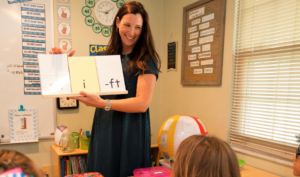Often, news reports will boast about the roughly 40% of students who have passed their statewide reading assessments. This may lead us to two questions: Is our collective reading curriculum catering to those students who would have learned to read anyway? And, what about the rest of the students?
After years of consistent assessment data reflecting these same numbers, we need to be asking ourselves, “How do we reach all students?” The answer to this question can be found in a good Science of Reading curriculum.
In education, a curriculum is broadly defined as the sum of student experiences that make up the educational process. This may refer to a planned sequence of instruction or to the student’s experiences that result from the instructional goals identified by the teacher.
So, what does a really good Science of Reading curriculum look like?
Learning to read is a multi-faceted skill – think of it as an umbrella. Within this overarching umbrella lies the mastery of essential language comprehension (background knowledge, vocabulary, language structures, verbal reasoning, literacy knowledge) and word recognition (phonological awareness, decoding, sight recognition) components.
These components are “woven” together (Scarborough, 2001) within the brain’s processing systems for skilled reading development. Evidence-based practices in reading instruction are derived from the Science of Reading.
Structured literacy is an approach to teaching reading that is based on the science of reading and years of brain research that provides us with information about how people acquire and process information.
The Science of Reading-aligned approaches target key skill areas represented in reading science so that all students can become skilled readers. A good Science of Reading curriculum is developed based on the elements of structured literacy.
If a curriculum is defined as a learning “experience,” then a well-designed Science of Reading curriculum would include the following foundational components in a structured approach:
Assessment
Assessment drives IMSE’s curriculum. The importance of assessment at the helm of any good reading curriculum is twofold: Assessment informs teachers on what skills students have and have not mastered. Secondly, assessment data provides a comparison to baseline, which allows us to monitor student progress effectively.
When teachers are knowledgeable about literacy development, they can use data from decoding and encoding assessments to pinpoint gaps in knowledge, error patterns, and habits. The diagnostic aspect of structured literacy requires teachers to continually monitor the progress of students as they learn to read using standard, measurable methods of assessment.
Scope and Sequence
Structured literacy is based on a well-developed curriculum that is systematic, sequential, and cumulative. By using a systematic and cumulative approach, structured literacy remains organized and logical, starting with the easier, basic concepts and scaffolding upon learned skills to more advanced concepts.
Phonological Awareness
Touted by researchers as one of the most critical components of effective early instruction is phoneme awareness skills. Awareness of these skills must be mastered for students to be fluent in reading and proficient with their spelling. Students need a strong foundation of competency in this area to make sense of phonics.
However, many classrooms offer little to no instruction in phonological awareness skills, and as a result, many kids fall behind over time. Phonemic awareness is a must-have in an excellent reading curriculum.
Phonics
Phonics, the study of relationships between sounds and written language, is essential for any significant reading curriculum.
Orton-Gillingham is a widely recognized method that focuses on multi-sensory techniques that combine the teaching of both reading and spelling simultaneously. Teachers can utilize many engaging, multisensory techniques to keep learners excited about learning new concepts and skills.
Developing a solid understanding of phonics complements the other components involved in the science of reading.
Spelling instruction and practice
Directly following the introduction of a new concept or spelling rule, students should be given guided opportunities to apply their skills to word and sentence dictation.
Teaching students an encoding strategy, like “finger tapping,” allows them to auditorily discriminate and “feel” each phoneme within a word or syllable as they state the sounds. “Pounding” teaches students to identify the syllables within multisyllabic words.

“Arm tapping” enhances motor muscle memory, promoting the students’ reading and spelling of irregular words as well as understanding why a word has an unexpected spelling.
Students should have ample practice with applying new knowledge and strategies to both reading and spelling.
Fluency work
As each skill or concept is learned, students will need repeated opportunities to apply their knowledge to phrase, sentence, and passage reading. The more they can devote their attention to the meaning of the text without laboring over word recognition, the more likely they will become fluent readers.
Daily fluency practice is an essential part of a good reading curriculum and directly benefits the student’s reading comprehension. Brief blending drills can improve automaticity and accuracy, which will enhance decoding at the multisyllabic word level. Students should engage in multiple opportunities to practice fluency with both decodable and grade-level text.
Rapid word charts for green (phonetic: real and nonsense) and red words (irregular), decodable sentences, oral reading fluency, and controlled text options should be embedded throughout the curriculum and for home practice to enhance orthographic mapping.
Essentially, students need to read, read, read!
Comprehension Strategies
Any effective Science of Reading curriculum must also explicitly develop comprehension skills, emphasizing the direct teaching of strategies such as predicting, summarizing, questioning, and inferencing. These can be activated before, during, and after reading.
Comprehension-building skills include the critical importance of developing vocabulary and background knowledge for text reading, using a content-rich curriculum that extends the topics and subjects that students are learning about in class.
Essential skills, such as finding the main idea and generating a summary, generalize better if they are practiced in the context of discovery around a meaningful topic.
Diverse Vocabulary Work
Vocabulary size varies widely by grade, and students can acquire new words both implicitly and directly. A good Science of Reading curriculum will consider ways to launch an “exponential effect” on word knowledge. A supportive curriculum will include direct instruction of specific words and word-learning strategies, extensive reading opportunities, and extension activities to prompt wordplay.
Engaging and Fun
 Good phonics instruction is implemented through a multi-sensory approach. It is hands-on and moves from direct, explicit instruction of a concept to extension activities and then to its direct practice application in reading and spelling.
Good phonics instruction is implemented through a multi-sensory approach. It is hands-on and moves from direct, explicit instruction of a concept to extension activities and then to its direct practice application in reading and spelling.
Tapping into the student’s sensory learning pathways is an essential part of every lesson. It is one of the hallmarks of the Orton-Gillingham method. Good phonics instruction should never be boring, rote, or dry.
A good Science of Reading curriculum will consider the student’s experience and tap into motivation to drive student engagement and confidence.
Professional Competency
Many literacy programs have been developed to close the literacy achievement gap, and there is currently a multitude of programs being implemented in classrooms across the country. While many of these programs provide teachers with content deemed “effective,” it is essential to remember that students learn through effective instruction, not through programs.
Despite having good content in their hands, many teachers have not been taught how spoken and written words work, and they are uncomfortable teaching students how to decode and spell. Teachers and administrators need to be well-versed in the Science of Reading to guide their selection of quality, evidence-based literacy programs and differentiate from the many currently being marketed options.
Once a good Science of Reading curriculum is selected, teachers need to gain competency in teaching critical skills such as the awareness of speech sounds, segmentation, manipulation of sounds, phoneme-grapheme correspondences, spelling patterns, and analysis of meaningful word parts (morphemes), and other skills and strategies.
References
Scarborough, H. (2001 Connecting early language and literacy to later reading (dis)abilities: Evidence, theory and practice. In S. Newman & D. Dickinson (Eds.), Handbook of Early Literacy Research, pp. 97-110. Guilford Press.
About the Author
 Dr. Kirstina Ordetx is a Level 4 Master Instructor with The Institute for Multi-Sensory Education (IMSE). She holds a doctorate in Counseling Psychology with a concentration in pediatric neurology. Dr. Ordetx is an educational specialist with over 25 years of clinical experience, research, and consultation. She is a certified Structured Literacy Dyslexia Interventionist through the Center for Effective Reading Instruction, a Certified Nutrition and Wellness Consultant, Executive Functions Coach, and a registered Licensed Mental Health Intern. Dr. Ordetx has published two books that compile her research and practice in Theory of Mind. She has served on accreditation committees for the Florida Council of Independent Schools, is a university adjunct professor in developmental and child psychology, and presents at various national and international conferences. Dr. Ordetx is head of school for a private academy in Lakewood Ranch, Florida specializing in the multi-sensory education of students who have language and learning-based differences. She is the Executive Director of the Pinnacle Pediatric Therapy Group, a multi-disciplinary, pediatric therapy clinic.
Dr. Kirstina Ordetx is a Level 4 Master Instructor with The Institute for Multi-Sensory Education (IMSE). She holds a doctorate in Counseling Psychology with a concentration in pediatric neurology. Dr. Ordetx is an educational specialist with over 25 years of clinical experience, research, and consultation. She is a certified Structured Literacy Dyslexia Interventionist through the Center for Effective Reading Instruction, a Certified Nutrition and Wellness Consultant, Executive Functions Coach, and a registered Licensed Mental Health Intern. Dr. Ordetx has published two books that compile her research and practice in Theory of Mind. She has served on accreditation committees for the Florida Council of Independent Schools, is a university adjunct professor in developmental and child psychology, and presents at various national and international conferences. Dr. Ordetx is head of school for a private academy in Lakewood Ranch, Florida specializing in the multi-sensory education of students who have language and learning-based differences. She is the Executive Director of the Pinnacle Pediatric Therapy Group, a multi-disciplinary, pediatric therapy clinic.
Sign up for our LIVE virtual Orton-Gillingham training! We are now offering half-day, evening, and weekend options to best fit your schedule.
The IMSE approach allows teachers to incorporate the five components essential to an effective reading program into their daily lessons: phonemic awareness, phonics, vocabulary, fluency, and comprehension.
The approach is based on the Orton-Gillingham methodology and focuses on explicit, direct instruction that is sequential, structured, and multi-sensory.
It is IMSE’s mission that all children must have the ability to read to fully realize their potential. We are committed to providing teachers with the knowledge and tools to prepare future minds.
Please connect with us on Facebook, Twitter, and Pinterest to get tips and tricks from your peers and us. Read the IMSE Journal to hear success stories from other schools and districts, and be sure to read the OG Weekly email series for refreshers and tips.
